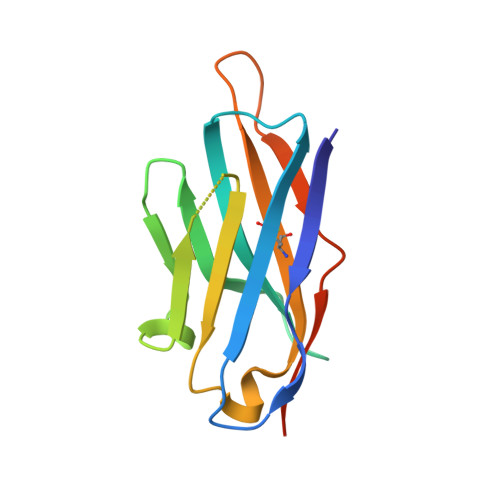Nanobody binding to a conserved epitope promotes norovirus particle disassembly.
Koromyslova, A.D., Hansman, G.S.(2015) J Virol 89: 2718-2730
- PubMed: 25520510
- DOI: https://doi.org/10.1128/JVI.03176-14
- Primary Citation of Related Structures:
4X7C, 4X7D, 4X7E, 4X7F - PubMed Abstract:
Human noroviruses are icosahedral single-stranded RNA viruses. The capsid protein is divided into shell (S) and protruding (P) domains, which are connected by a flexible hinge region. There are numerous genetically and antigenically distinct noroviruses, and the dominant strains evolve every other year. Vaccine and antiviral development is hampered by the difficulties in growing human norovirus in cell culture and the continually evolving strains. Here, we show the X-ray crystal structures of human norovirus P domains in complex with two different nanobodies. One nanobody, Nano-85, was broadly reactive, while the other, Nano-25, was strain specific. We showed that both nanobodies bound to the lower region on the P domain and had nanomolar affinities. The Nano-85 binding site mainly comprised highly conserved amino acids among the genetically distinct genogroup II noroviruses. Several of the conserved residues also were recognized by a broadly reactive monoclonal antibody, which suggested this region contained a dominant epitope. Superposition of the P domain nanobody complex structures into a cryoelectron microscopy particle structure revealed that both nanobodies bound at occluded sites on the particles. The flexible hinge region, which contained ~10 to 12 amino acids, likely permitted a certain degree of P domain movement on the particles in order to accommodate the nanobodies. Interestingly, the Nano-85 binding interaction with intact particles caused the particles to disassemble in vitro. Altogether, these results suggested that the highly conserved Nano-85 binding epitope contained a trigger mechanism for particle disassembly. Principally, this epitope represents a potential site of norovirus vulnerability.
Organizational Affiliation:
Schaller Research Group at the University of Heidelberg and the DKFZ, Germany, Heidelberg, Germany, and Department of Infectious Diseases, Virology, University of Heidelberg, Germany, Heidelberg, Germany.















